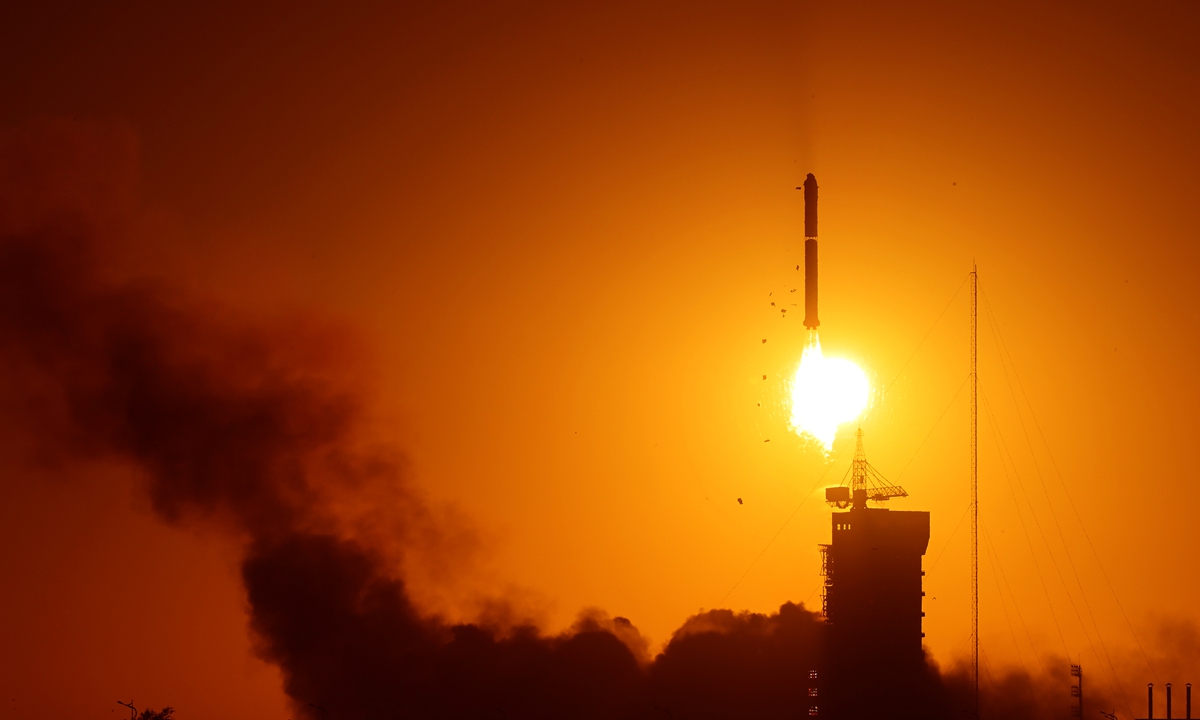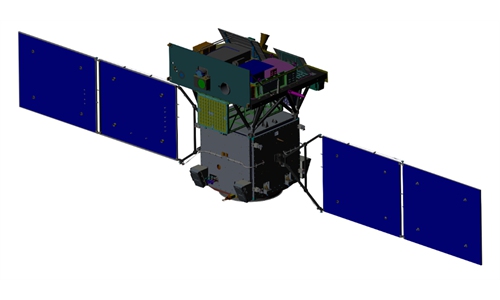
China sends the Kuafu-1 satellite into a preset orbit via a Long March 2D carrier rocket on October 9, 2022 from the Jiuquan Satellite Launch Center in Northwest China's Gansu Province. Photo: Wang Jiangbo
China sent the country's Advanced Space-based Solar Observatory (ASO-S) - a satellite specially designed to carry out a comprehensive probe of the Sun - into preset orbit via a Long March 2D carrier rocket on Sunday morning from the Jiuquan Satellite Launch Center in Northwest China's Gansu Province.
The satellite, also known as Kuafu-1, which is named after Kuafu, a giant in Chinese mythology who indefatigably chased the sun, was jointly developed by the Innovation Academy for Microsatellites of the Chinese Academy of Sciences (CAS,) CAS National Astronomical Observatory, the CAS Changchun Institute of Optics, Fine Mechanics and Physics and the CAS Purple Mountain Observatory. Nanjing-based CAS Purple Mountain Observatory will operate the spacecraft, the Global Times learned from mission insiders.
Dubbed China's first comprehensive solar probe, Kuafu-1 will conduct continuous solar observations for at least four years, and its main scientific goals include the formation of the solar magnetic field, solar flares and titanic blasts known as coronal mass ejections, as well as their relationship in a simultaneous fashion, Gan Weiqun, the program leader and a research fellow with the Purple Mountain Observatory, told the Global Times on Sunday.
Chinese scientists will also use the satellite to support space disaster weather forecasts that might affect high-tech activities such as human spaceflights, communication and navigation, the Global Times learned from a statement the developers provided on Sunday.
To achieve these goals, the Kuafu-1 carries three payloads - the Lyman-alpha telescope (LST), Hard X-ray telescope (HXT) and Full-disk solar vector MagnetoGraph (FMG,) according to Gan.

Schematic diagram of Kuafu-1 Photo: Purple Mountain Observatory, Chinese Academy of Sciences
It marks a world's first to observe the solar magnetic field, solar flares and titanic blasts, and deploy a corresponding payload combination onboard all at once. It is also a world's first in deploying a near-Earth satellite platform to detect the all-solar vector magnetic field and the non-thermal radiation of solar flares, as well as to simultaneously observe images, heliostat formation and coronal propagation of coronal mass ejections.
Also marking a world's first, the Kuafu-1 will realize simultaneous imaging of the full heliosphere and the corona via the LST, Gan added.
With a designed service life of four years, Kuafu-1 will work in the Earth's polar orbit some 720 kilometers above ground, so that it will be capable of conducting 24-hour continuous observation directly of the Sun, with a rather short communication delay, according to Gan.
Naming the satellite after Kuafu also represents the heroic and tenacious spirits of ancient Chinese ancestors in exploring nature and the Chinese people's unremitting quest to uncover the mystery of the Sun, developers revealed.
Gan said that the satellite would enter formal service after a testing period of four to six months.
Li Hui, another research fellow with the Purple Mountain Observatory and chief designer of the scientific application system of the satellite, told the Global Times that after testing, data collected by the spacecraft will be open to scientists and researchers all over the world in a timely fashion, free of charge.
Li added that such a sharing policy is also in line with international norms, which Chinese solar physicists have enjoyed and benefited from. "Therefore, we shall fully open data collected by our comprehensive solar probe," said Li.
According to developers, the three sets of payloads on the Kuafu-1 will collect around 500 gigabytes of data every day and that will be open to global researchers.
NASA launched the Parker Solar Probe in 2018, which adopted a rather bold method of being the first to fly directly through the Sun's corona - the hazardous region of intense heat and solar radiation in the Sun's atmosphere that is visible during an eclipse.
But the US probe, admittedly revolutionary, cannot yet look into the Sun directly all the time, as the telescope instruments cannot withstand heat of over 5,000 C, so its observations will not be as continuous as those of the ASO-S, Gan said.
Gan explained that Xihe, China's first solar probing satellite that attained state approval in June 2019 and was launched in October 2021, carries an H-alpha telescope that can be also deployed on Earth's ground but could overcome challenges including the atmospheric agitation when sent into space. It is dedicated to execute spectral imaging observations of the H-alpha band of the Sun and to mainly experiment with such technology.
Kuafu-1 has different yet more specific solar probing tasks, and it is designed to yield major scientific breakthroughs. So the deployment of the ASO-S marks a great leap in the domain.


